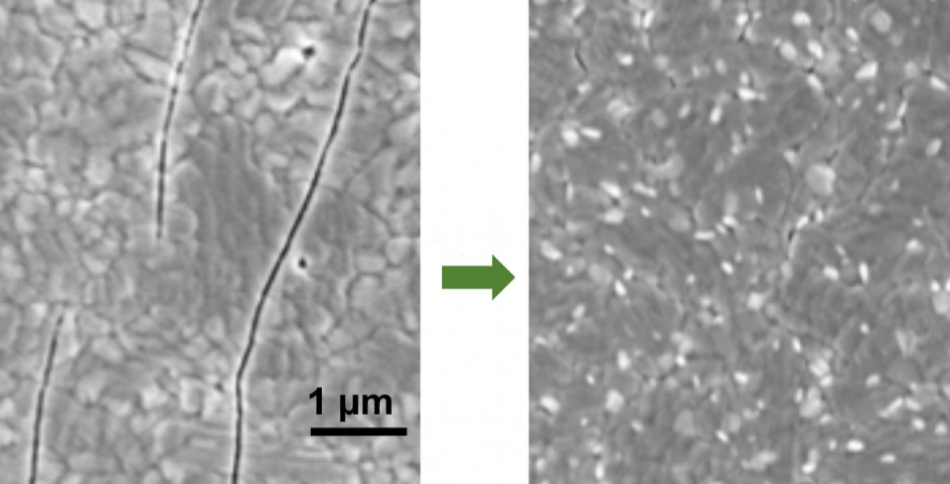Feb 13 2020
According to a recent study, perovskite materials can potentially be used in advanced solar cells. Published in the Acta Materialia journal, the study discovered that while perovskite films have a tendency to crack easily, such cracks can be easily healed with a little bit of heat or a certain amount of compression.
 A cracked perovskite film (left) can be fully healed (right) with some compression or a little heat. Image Credit: Padture Lab/Brown University.
A cracked perovskite film (left) can be fully healed (right) with some compression or a little heat. Image Credit: Padture Lab/Brown University.
According to scientists, the discovery bodes well for using low-cost perovskites to complement or substitute expensive silicon that is typically used in solar cell technologies.
The efficiency of perovskite solar cells has grown very quickly and now rivals silicon in laboratory cells. Everybody’s chasing high efficiency, which is important, but we also need to be thinking about things like long-term durability and mechanical reliability if we’re going to bring this solar cell technology to the market. That’s what this research was about.
Nitin Padture, Study Lead and Professor, School of Engineering, Brown University
Padture is also the director of the Institute for Molecular and Nanoscale Innovation at Brown University.
Perovskites are a broad group of crystalline materials, and in the year 2009, they were initially integrated into solar cells. These previous generations of perovskite solar cells had a power conversion efficiency of about 4%, but currently, that efficiency surpasses 25%—fundamentally the same as conventional silicon.
Perovskite solar cells offer one major benefit, that is, they can be developed at a fraction of the cost of silicon, thus potentially reducing the cost associated with the installations of solar power. In addition, perovskites can be fabricated into thin films that are both flexible and semi-transparent, possibly paving the way for flexible, lightweight solar cells in backpacks or tents, or energy-generating windows.
However, the ease and affordable way of producing perovskite solar cells come with a cost.
In material science, things that are easy to make also tend to be easy to break. That’s certainly true of perovskites, which are quite brittle. But here we show they’re also quite easy to fix—cracks in perovskite films can be healed by compressing them or with moderate heat.
Nitin Padture, Study Lead and Professor, School of Engineering, Brown University
Padture headed the research.
For the latest study, Srinivas Yadavalli, the first author of the study and a doctoral student working in Padture’s laboratory, deposited perovskite films on plastic substrates. Yadavalli subsequently bent the substrate to place tensile (pulling apart) stress on the perovskite film and, at the same time, used a scanning electron microscope (SEM) to identify cracks.
When cracks occurred on the film, the scientists bent the substrate in the revere direction to check if those cracks can be healed by compressive stress. And sure enough, the cracks disappeared completely as shown by SEM imaging.
To ensure that the cracks were completely healed and not simply concealed, the team employed a method called X-ray diffraction. By quantifying the size of the atomic lattice of a material, this method can show whether a previously cracked site is currently able to carry a mechanical load—a definite sign that the crack is indeed healed. Fully healed cracks were also indicated by those tests.
The researchers found that heat was equally effective in healing the cracks. Temperatures of up to 100 °C—relatively modest heating by material science standards—were sufficient to fully heal the cracks in perovskite films.
According to Padture, the main aim of this study was to get a deeper insight into the fundamental characteristics of perovskite materials, and added that more research needs to be performed to develop new ways of using this information in a commercial setting.
However, knowing that perovskite films are easily healed may prove handy as these types of solar cells shift toward commercialization.
It’s good news. It suggests that fairly simple healing methods may help maintain performance in these kinds of solar cells.
Nitin Padture, Study Lead and Professor, School of Engineering, Brown University
Zhenghong Dai, Hua Zhou, and Yuanyuan Zhou were the co-authors of the study. The study was financed by the Office of Naval Research (N00014-17-1-2232) and the National Science Foundation (OIA-1538893). It used resources of the Advanced Photon Source, a Department of Energy Office of Science User Facility operated by Argonne National Laboratory (DE-AC02-06CH11357).